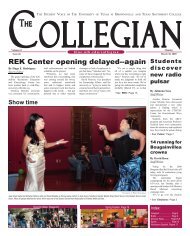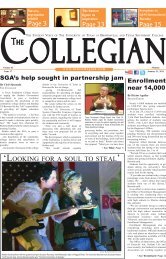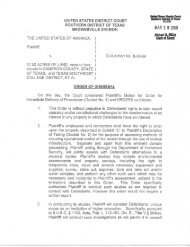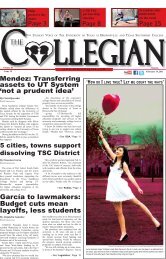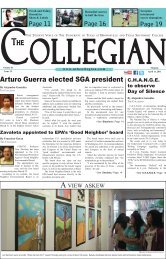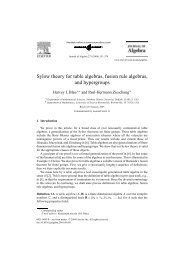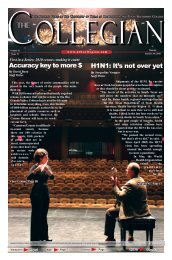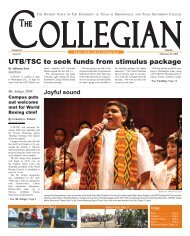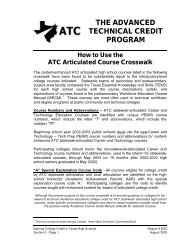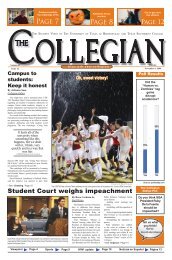cameron county/matamoros - blue - The University of Texas at ...
cameron county/matamoros - blue - The University of Texas at ...
cameron county/matamoros - blue - The University of Texas at ...
You also want an ePaper? Increase the reach of your titles
YUMPU automatically turns print PDFs into web optimized ePapers that Google loves.
UTB-CBIRD Report: “At <strong>The</strong> Crossroads” Economic Development 134<br />
Action Initi<strong>at</strong>ives 1<br />
<strong>The</strong> U.S./Mexico border has one <strong>of</strong> the fastest growing popul<strong>at</strong>ions in the n<strong>at</strong>ion<br />
and regional healthcare delivery is severely constrained by a longstanding<br />
scarcity <strong>of</strong> physicians, dentists, nurses, and allied healthcare providers. <strong>The</strong><br />
regions’ transit (e.g., Winter Texans and Mexicans) and resident popul<strong>at</strong>ion<br />
presents unique healthcare problems such as bin<strong>at</strong>ional and bicultural<br />
challenges to wellness educ<strong>at</strong>ion, teenage pregnancy, diabetes, drug resistant<br />
TB, and cross-border bio-terrorism. However, the popul<strong>at</strong>ion mix also provides a<br />
“unique living labor<strong>at</strong>ory environment” for problem-centered R&D and for<br />
bin<strong>at</strong>ional healthcare educ<strong>at</strong>ion and training programs th<strong>at</strong> focus on the unique<br />
healthcare needs <strong>of</strong> the Lower Rio Grande Valley.<br />
<strong>The</strong>re is a lack <strong>of</strong> worldclass research on border healthcare problems and such<br />
research activities could establish a new vision <strong>of</strong> healthcare business and<br />
manufacturing growth for the Valley. Perhaps more than any other region <strong>of</strong> the<br />
U.S. the Lower Rio Grande Valley needs to embrace a multi-disciplinary approach<br />
to healthcare. Teams <strong>of</strong> doctors, nurses, and other healthcare pr<strong>of</strong>essionals<br />
need to tre<strong>at</strong> the “Border P<strong>at</strong>ient” in terms <strong>of</strong>:<br />
⇒ <strong>The</strong> importance <strong>of</strong> different cultural and ethnic backgrounds on<br />
healthcare challenges and cures as well as “Wellness Educ<strong>at</strong>ion” and<br />
prevent<strong>at</strong>ive healthcare<br />
⇒ Environmental challenges on the border and how they impact regional<br />
public health – including w<strong>at</strong>er use in arid lands, pollution, and<br />
healthcare issues specific to colonials<br />
⇒ Healthcare <strong>at</strong>titudes and beliefs rel<strong>at</strong>ed to mental health and<br />
psychological issues specific to border regions<br />
⇒ Healthcare concerns specific to the elderly a fast growing segment <strong>of</strong><br />
the border popul<strong>at</strong>ion<br />
⇒ Healthcare concerns specific to the young – teenage pregnancy,<br />
substance abuse, alcoholism<br />
⇒ Sexual transmitted diseases, e.g., HIV/AIDS where the fastest growing<br />
group is heterosexual females which had an increase <strong>of</strong> 433% during<br />
2000-2001, it is predicted th<strong>at</strong> there will be a 500% increase in AIDs<br />
p<strong>at</strong>ients in the border region over the next 60 years<br />
⇒ Research on diseases th<strong>at</strong> are most prevalent in the border region such<br />
as Diabetes and Drug resistant TB<br />
Regional Healthcare<br />
<strong>The</strong> Lower Rio Grande Valley needs to better link and leverage regional assets on<br />
both sides <strong>of</strong> the border to meet border healthcare challenges and concerns and<br />
to link with the regional healthcare clusters including educ<strong>at</strong>ion and training,<br />
business retention and development, and other border-specific issues. Regional<br />
Healthcare Focus Group 2 Participants noted the following:<br />
“We are fractionalizing Border healthcare, preventive care, and healthcare<br />
delivery. <strong>The</strong>re are too many restrictions and too much compartmentaliz<strong>at</strong>ion.<br />
<strong>The</strong>re is a general lack <strong>of</strong> collabor<strong>at</strong>ive efforts by all healthcare providers in the<br />
LRG Valley. <strong>The</strong> St<strong>at</strong>e’s medical plan needs to be revamped currently it has<br />
1 <strong>The</strong>se action initi<strong>at</strong>ives are based on discussions <strong>at</strong> the Future <strong>of</strong> the Region, Regional Forum –<br />
Lower Rio Grande Valley Council <strong>of</strong> Governments – Healthcare Issues Focus Group. Conference Co-<br />
Hosts: <strong>Texas</strong> Center for Border Economic and Enterprise Development, <strong>The</strong> <strong>University</strong> <strong>of</strong> <strong>Texas</strong> <strong>at</strong><br />
Brownsville and <strong>Texas</strong> Southmost College; <strong>Texas</strong> St<strong>at</strong>e Technical College; and Lower Rio Grande<br />
Valley Development Council, Harlingen <strong>Texas</strong>, June 25, 2002.<br />
2 Ibid.<br />
Una Region -- Un Futuro<br />
<strong>The</strong> Border Region needs<br />
centers <strong>of</strong> research<br />
excellence th<strong>at</strong> focus on<br />
border healthcare<br />
challenges. <strong>The</strong> region<br />
will not have excellence<br />
in healthcare unless it<br />
has excellence in<br />
research within the<br />
region (not loc<strong>at</strong>ed in<br />
Houston or San Antonio)<br />
and in medical areas<br />
th<strong>at</strong> target border<br />
healthcare needs.



